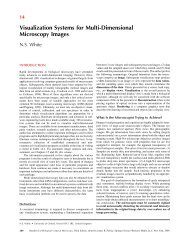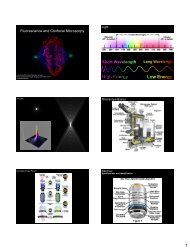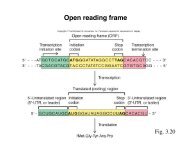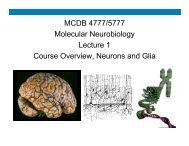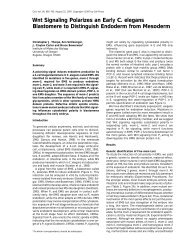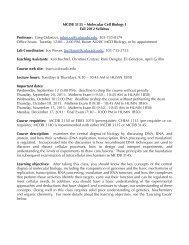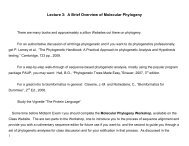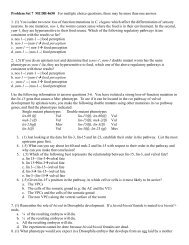2012 Program Booklet - MCD Biology - University of Colorado Boulder
2012 Program Booklet - MCD Biology - University of Colorado Boulder
2012 Program Booklet - MCD Biology - University of Colorado Boulder
Create successful ePaper yourself
Turn your PDF publications into a flip-book with our unique Google optimized e-Paper software.
Michael B. Yaffe, PhD<br />
Pr<strong>of</strong>essor, Department <strong>of</strong> <strong>Biology</strong><br />
Massachusetts Institute <strong>of</strong> Technology (MIT)<br />
Title: Systems <strong>Biology</strong> Approaches to<br />
Optimizing Cancer Treatment<br />
Saturday, October 13<br />
9:20 – 10:15 am<br />
JSCBB Butcher Auditorium<br />
Abstract:<br />
Most current anti-‐cancer drugs function by one <strong>of</strong> two general mechanisms: (1) targeting specific signaling<br />
molecules, particularly protein kinases and growth factor receptors; and (2) inducing cytotoxicity through DNA<br />
damage or disruption <strong>of</strong> the mitotic spindle. Targeted agents/signaling inhibitors, when used as<br />
monotherapies for cancer treatment are non-‐curative. Although these drugs can induce dramatic tumor<br />
regression, and occasionally prolonged remissions, the cancers invariably recur. Alternatively, cytotoxic<br />
therapies that damage DNA have a long history <strong>of</strong> successful use as anti-‐neoplastic agents. However, patient<br />
responses to DNA damaging drugs vary greatly, and heterogeneity within any single tumor can lead to the<br />
emergence <strong>of</strong> a resistant sub-‐population <strong>of</strong> cells. The DNA damage from exposure <strong>of</strong> tumor cells to these<br />
cytotoxic agents is processed by a complex interacting network <strong>of</strong> signaling pathways involving protein<br />
kinases, phosphoserine/ threonine-‐binding domains (14-‐3-‐3 proteins, FHA domains, BRCT domains), and<br />
ubiquitin/SUMO modifying enzymes. The outputs <strong>of</strong> these DNA damage-‐activated pathways must be<br />
integrated with additional extracellular and intracellular cues such as cytokines and growth factor signals to<br />
control the resulting cellular response – cell cycle arrest, DNA repair, apoptosis or senescence. How this array<br />
<strong>of</strong> diverse signals is functionally integrated and processed, and how these signal integration events can be<br />
influenced by combinations <strong>of</strong> anti-‐cancer therapies to enhance tumor cell killing is unknown.<br />
To address this, we have been developing systems biology-‐based models <strong>of</strong> DNA damage signaling<br />
where gene expression signatures, kinase activities, protein phosphorylation, and phosphoprotein-‐binding<br />
events for multiple signaling pathways are quantitatively measured at densely sampled points in time, along<br />
with cellular responses such as cell cycle arrest, autophagy, and apoptosis. The resulting large dataset <strong>of</strong><br />
signals and responses are then related to each other mathematically using partial least squares regression,<br />
principal components analysis, and time-‐interval stepwise regression. We have used this approach to examine<br />
the response <strong>of</strong> breast cancer and osteosarcoma cells to DNA damaging chemotherapy and gamma radiation<br />
in the presence or absence <strong>of</strong> small molecule inhibitors <strong>of</strong> growth factor signaling pathways. The resulting<br />
models, built from thousands <strong>of</strong> signaling measurements and hundreds <strong>of</strong> cellular response assays, reveals<br />
surprisingly paradoxical context-‐dependent roles for the MEK-‐Erk and p38/MK2 kinase signaling pathways in<br />
controlling cell cycle arrest, apoptosis and senescence after DNA damage. Using this approach, we recently<br />
identified a novel time-‐staggered combination therapy in which EGFR inhibitor pre-‐treatment is used to<br />
dramatically enhance DNA damage-‐induced cell death in a subset <strong>of</strong> triple-‐negative breast cancers by dynamic<br />
re-‐wiring <strong>of</strong> apoptosis pathways. The results from these systems-‐based studies illustrate the importance <strong>of</strong><br />
measuring time-‐dependent changes in signaling pathways in evaluating and optimizing the effects <strong>of</strong> anti-‐<br />
cancer drugs, and show the utility <strong>of</strong> a new concept – therapeutic network re-‐wiring – in designing novel<br />
combination therapies with greater anti-‐tumor efficacy.




